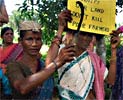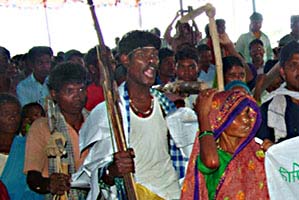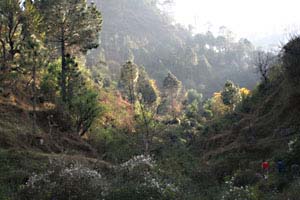Sponge Iron Industries - 2
Pollution and displacement
See also: Sponge Iron Industries - part 1: resistance
overview photo series about pollution
Fast growing production
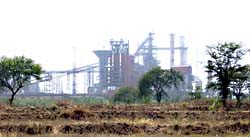 The last ten years hundreds of iron factories were constructed in the centre of India.
The last ten years hundreds of iron factories were constructed in the centre of India.
We will give some more background information about the scale of the iron production, pollution, health problems and the lack of employment for local people. We quote from the book Sponge Iron Industries [1]. More pictures iron factories
(page 5) “India is the largest producer in the world of sponge iron, a product derived from iron and used
to make steel. Post 1990’s neo-economic policies played a major role in de-licensing this sector and allowing
private players to enter with 100% Foreign Direct Investment. Higher subsidies on electricity, liberalisation of import
technology and reduction of custom duty on raw material has contributed in increased number of Sponge Iron Units (SIUs)
in India, which grew from 3 plants in 1989 to more than 350 operating plants in 2007.
(page 176) The ‘mushrooming’ of growth had started most markedly after 2002. (..) This trend has been
observed across the states, with around 72 % of the total units surveyed having come into operation after 2002.
(page 9) The sponge iron industry (..) that has mushroomed in the regions producing iron ore, is no different from other industries in terms of its ability to guzzle resources - land, forests, and water, followed by the lives of the people. However, if we compare it with projects such as large dams, infrastructure development, large integrated industries and green field projects - the sponge iron factories seem, on the face of it, ‘harmlessly’ small. After all, what damage can a 50 or a 100 tonne per day unit do? How much land does it need - a couple of acres, three or maybe four? Even the largest sponge iron plant in the country, belonging to Jindal Steel and Power Limited in Raigarh, has not displaced more than five-odd villages. This is a common response to questions raised about the impact of this industry.
But speak to any of the residents in the sponge iron hubs of Orissa, Chhattisgarh, Jharkhand or any other state, about how these factories have changed their lives, and we are likely to get a common answer - thick black smoke, contaminated water, depleting vegetation, falling agriculture production and poor health conditions. It is the unprecedented pollution by these units that is swallowing life, if not direct large scale land-acquisition. And perhaps it is even more dangerous because the consequences become visible only once a factory is operational.
Based on this, calling India the hub of one of the most polluting industries in the world would not be an exaggeration. Few of us may be aware that in the past five years India has emerged as the largest producer of sponge iron internationally.
(page 11) Today, about 20% of the sponge iron produced worldwide is made in India. In 2005-06 the product
ion of sponge iron in India was 16.3 million tonnes.
“The ‘China boom’ is often cited as the reason for the increase in the demand for iron ore
over the past decade. (..) Indian iron ore exports to China increased to 83 per cent in 2005-06 from 30 per cent
in 2000-01.” [2]
(page 12) Till the 1990s, there were only three SIUs in the country and these were public sector undertakings. It was the introduction of the DRI technology (Direct Reduced Iron), and the use of coal in sponge iron making, that made sponge iron production a cheap, low cost investment that had an open domestic steel market as its consumer.
But the key policies that really gave an impetus to the growth of a deregulated and private sponge iron sector
were: de-licensing of primary metallurgical industries after 1985, the New National Mineral Policy, and the New
Industrial Policy in the early 1990s which:
* Opened the industry for private and 100% Direct Foreign Investment
* Provided exemptions from compulsory licensing
* Made space for easy land acquisition and water availability
* Encouraged higher subsidies on electricity
* Promoted liberalisation of import technology and reduction of
customs duty on raw materials.
(..) According to the ministry of steel, in 2006-07, the installed capacity of sponge iron in India reached a whopping 163 lakh tonnes, from 12 tonnes in 1990-91. The market projection estimate shows that in the next five years, another estimated 70 lakh tonnes installed capacity of sponge iron will be created due to huge investments in expanding existing capacities and upcoming new green field steel projects.
(page 13) Survey of the Indian Sponge Iron Industry by the Joint Plant Committee in 2005-06 reported that India has 206 operating SIUs and another 225 coal based SIUs are being commissioned. Of the existing SIUs, 77 coal based projects are also being expanded.
A majority of these units have sprung up in tribal or backward districts. (..) These areas have rich reserves of iron ore and coal - the raw materials for sponge iron - besides offering cheap local labour and a lot of backhand support from state administrations.
(page 17) Coal based units are relatively easy to set up as they can be established with the help of local fabricators and suppliers. For a 100 TPD (Tonnes Per Day) sponge iron plant, the initial investment of Rs 120-160 million (2-2.7 million euro) is recovered in just 12-18 months because the profit margin is huge. With the current price of sponge iron at around Rs 10,500 per tonne (175 euro/tonne), a small unit can make a profit of about Rs 6 million (100,000 euro) a month.”
About mines: Chhattisgarh “had 136 mines of which 106 were opencast mines, nine were underground, 20
were small scale and one was a medium scale mine.” [3; page 26]
Pollution
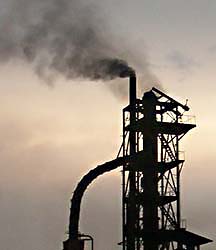 Ten years ago there was a beautiful forest here with fresh air. Now you almost cannot breath here.
Ten years ago there was a beautiful forest here with fresh air. Now you almost cannot breath here.
(page 19) “A visit to an average sponge iron area dominated by these factories leads to some immediately glaring revelations - the air is laden with smoke, the movements of trucks is high, the plants are located adjacent to or right in the middle of a village or villages, the houses in these villages - roofs and walls - are covered with dust, the leaves and forests in the vicinity are black and not green in colour, layers of soot accumulate on the skin, the eyes experience a burning sensation if long hours are spent in the area, dumps of char and iron ore scrap lie along the roadside. More pictures air pollution and dust
Most of the iron units either did not install ESPs (Electro Static Precipitators), mandatory to control
hazardous emissions, or do not run it to save money.
(..) SIUs emit what is referred to as ‘suspended particular matter’ or SPM which contains cadmium,
nickel, hexavalent chromium, arsenic, manganese, and copper which are considered fatal even in small doses. These
carcinogenic (cancer causing) wastes are emitted from the stacks or the chimneys in the plant.
(..) While this is a direct form of air pollution that occurs from the stack, most of the sponge iron hubs and
areas are facing issues of widespread vehicular pollution by trucks that carry the raw and finished material. The
spread of dust from loading and unloading of raw materials is yet another hazard. Solid waste generated by these
plants in the form of char and fly ash, which is openly dumped in or outside the factory premises, in fields and
forests, is also carried by the wind, polluting the air further.
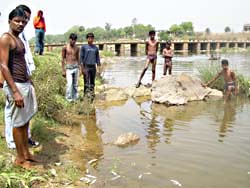 The villagers cannot eat fish any longer. The fishes died by the water pollution.
The villagers cannot eat fish any longer. The fishes died by the water pollution.
Many a time the solid waste is dug into the ground, polluting ground water. The direct disposal of industrial
effluents and coal washeries into rivers and streams is a common phenomenon. The other method that is used for
disposal is building of waste water ponds in the factory campus. This stored toxic water then seeps into the ground
contaminating the ground water. Even a large company like Jindal Steel and Power Ltd dumps fly ash in the nearby
school ground, riversides and in forest areas and roadsides."
More pictures water pollution
Health impacts
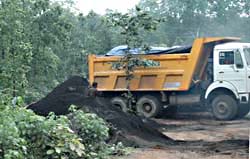 The factories dump their poisonous waste everywhere.
The factories dump their poisonous waste everywhere.
(page 21) “Iron acts along with other carcinogenic heavy metals to increase cancer risk. The toxic effects of heavy metals are varied and may often manifest after a prolonged period, sometimes several years, as in the case of cancer. SIUs also emit oxides of sulphur and nitrogen and hydrocarbons. These air pollutants are likely to increase the incidence of respiratory tract ailments, e.g., cough, phlegm, chronic bronchitis and also exacerbate asthmatic conditions. More pictures dumping
The other health impacts include:
* damage to the nervous system especially among children due
to exposure to lead and mercury
* danger of kidney ingestion due to mercury
* skin irritation and various other skin diseases
* impact on women’s health and reproductive system
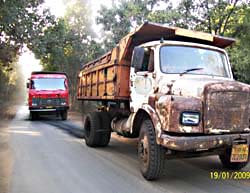 The heavy traffic gives a lot of noise and air pollution, but also kills many
villagers in traffic accidents.
The heavy traffic gives a lot of noise and air pollution, but also kills many
villagers in traffic accidents.
Increasing accidents due to heavy traffic and movement of trucks in areas like Keonjhar and Raigarh is another common occurrence leading to deaths and physical disabilities. More pictures traffic
It is not just human health that is affected by the pollution; domestic animals, especially livestock such as cattle are also affected.
(page 77 - about East-Indian state West Bengal) A major concern in hazardous industries such as the sponge
iron industry is health check-ups for workers. There are no regular health check-ups and in-house medical facilities
are virtually absent. In most cases there is not even a first aid service available on the factory premises. All this
is a gross violation of Factory Rule 41 (C) related to hazardous industry.
Most statuary requirements of Worker’s Safety and Prevention of Occupational Diseases in Hazardous Process
are not followed by the sponge iron and Ferro alloy industries. Workers reported respiratory problems, chronic
cough and cold, eye irritation, skin diseases, weakened vision and general debilities, anemia, indigestion, etc.
(page 79) The effluents of the local sponge iron and ferro alloy units run into various rivers and canals. The Tangla river is turbid and heavy with pollutants leading to a high incidence of skin disorders, especially in communities using the river for washing and bathing.”
Employment
(page 22) “Villages in the periphery of SIUs have their agricultural lands rendered almost unproductive with the increasing accumulation of dust and air emissions on the soil.
(page 28) Despite the fact that employment by SIUs is of a contractual, non-permanent and unskilled nature for
which local people can qualify, it has become the practice for contractors to bring labourers from neighbouring
states rather than employ local people. The key reasons being that outsiders are easier to exploit. (..) Employment
promised at the time of commencement of the plant in the area is never given once that plant starts functioning.
(..) In July 2005, in an accident at the Jindal Steel Plant in Raigarh, three people died in an accident in the
plant and the company could not be held accountable as the labourers were employed by local contractors.
(page 39) The main occupation of the people in most villages (of the Centre-Indian state Chhattisgarh) is
agriculture. (..) According to the 1991 census, 84 % of the population of the Raigarh district is dependent on the
farm sector for employment; of these 29 % are agricultural labourers. (..) Since the year 1991, more than 1200
hectares of agricultural land has been transferred to industry in Raigarh, most of it for sponge iron units. The
most transfers of land occurred after 1998, and accelerated further after 2002.
(..) Industries have acquired agricultural land by using all kinds of tactics, from money to force and
harassment. ‘Encroachment’ is one of the most common patterns used by the big as well as the small
plants. JPSL (Jindal Steel and Power Ltd.), based in Saraipali and Patrapali, blocked paths to villages; Ind.
Agro Sponge Iron Ltd. destroyed agriculture fields by dumping truckloads of raw material and fly ash on them
overnight. The dumping of solids and wastes destroyed the fields of poor villagers who were left no option but to
sell their lands.”
Displacement
From a report about Chhattisgarh of the international development organisation Action Aid [3]: (page 47) “A total of 146,500 acres (59,300 ha) of land has been acquired for water, industry and mines (in several) districts of Chhattisgarh as per the available data mainly during 1991-07.
(page 26) The total of displaced persons is 157,000 and project affected persons 701,000. (page 47) Out of these tribals are 94 per cent
(..) 88 per cent of the respondents said they did not get adequate compensation and researchers discovered that only 1 per cent of the respondents lodged complaints against improper compensation. People were not aware of the amount and procedure of the compensation.
When we focus on the few people who were resettled we see (page 47) “facilities such as power supply declined from 48 per cent to 27 per cent, and schooling facilities declined from 48 per cent to 27 per cent after displacement. The availability of places of worship declined from 50 per cent to 26 per cent and the availability of graveyards declined from 45 per cent to 22 per cent. Health care declined from 42 per cent to 25 per cent.
(..) The loss of the forest also entails a serious blow to the socio-cultural life of the tribal communities. (..) 42 per cent of the respondents report increased deforestation since displacement. 51 per cent report that their food sources have been adversely affected as a result. Water sources are dwindling.
Sources
1. Infopack on Sponge Iron Industries - issues and campaigns; Manshi Asher, Rifat Mumtaz; National Centre for Advocacy Studies; Pune, Maharashtra, India, 2007.2. ‘Mines of Scandal’; Vikhar Ahmed Sayeed in Frontline from February 13, 2009.
3. Resource Rich Tribal Poor - displacing people, destroying identity in India’s indigenous heartland - Chhattisgarh report; ActionAid India; New Delhi, 2008.
See also: Sponge Iron Industries - part 1: resistance
Go to next page: photo series about iron factoriesDownload report: Pollution by Iron Factories in Chhattisgarh (pdf 7 MB)
